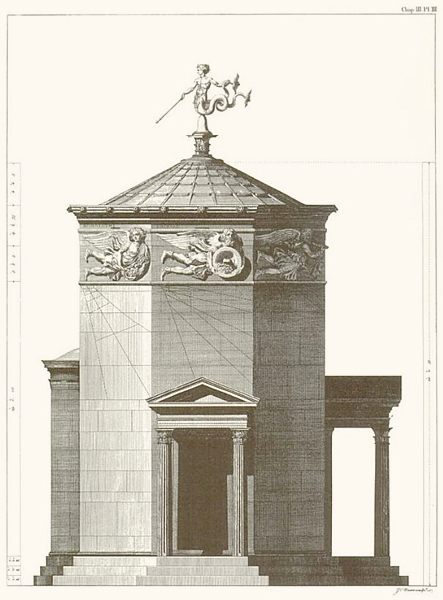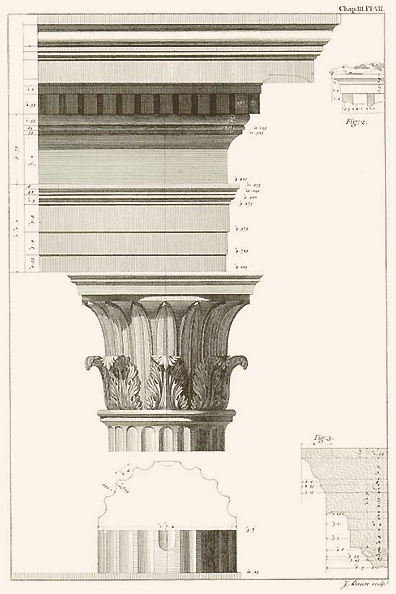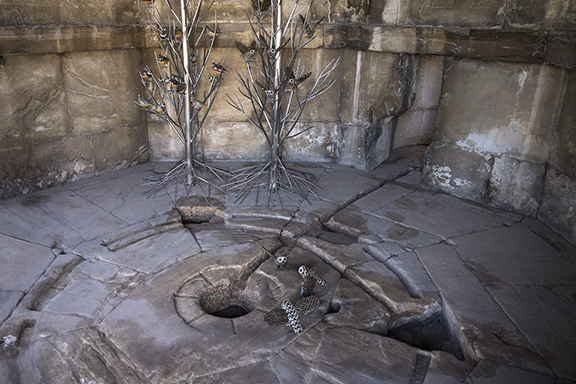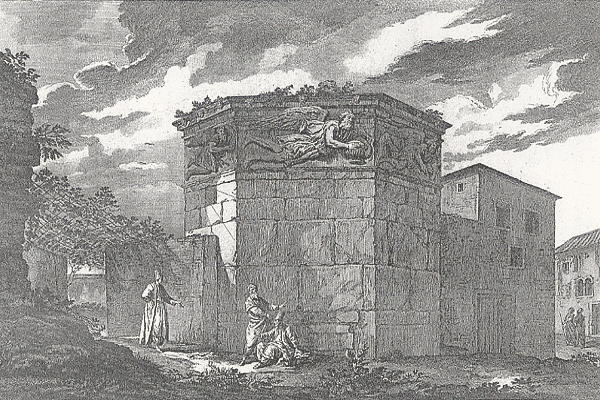
"But Athens the Mother of elegance and politeness, whose magnificence scarce yielded to that of Rome, and who for the beauties of a correct style must be allowed to surpass her; has been almost entirely neglected. So that unless exact copies of them be speedily made, all her beauteous Fabricks, her Temples, her Palaces, now in ruins, will drop into Oblivion; and Posterity will have to reproach us, that we have not left them a tolerable Idea of what was so excellent, and so much deserved our attention; but that we have suffered the perfection of an Art to perish, when it was perhaps in our power to have retrieved it....We have therefore resolved to make a journey to Athens; and to publish at our return, such Remains of that famous City as we may be permitted to copy, and that appear to merit our attention."
Proposals for publishing an accurate description of the Antiquities of Athens (1748)
With an easing of diplomatic relations in the mid-eighteenth century, it became possible for an intrepid traveler to visit Greece, which then was part of the Ottoman Empire and largely had been closed to Europeans since the destruction of the Parthenon by the Venetians in 1687 and their expulsion the next year. In 1751, the English architects James Stuart and Nicholas Revett announced a proposal that they had conceived of several years earlier in Rome. Their intention was to systematically survey the principal monuments of Athens in three folio volumes, with engraved plates and a descriptive text in hope that "a performance of this kind might contribute to the improvement of the Art [of architecture] itself" (p. i). Stuart made notes and picturesque gouache paintings of the ruins, and Revett their systematic measurements. By the beginning of 1755, they were back in London, where Stuart spent much time supervising the engraving, preparing the text, designing the binding—and marrying his housekeeper. To the increasing impatience of subscribers (and Revett himself), the first volume of The Antiquities of Athens did not appear until 1762, more than a decade after its authors first had left for Greece and seven years after their return. Publication was so delayed that, the year before, William Hogarth had lampooned the fact in a satirical print entitled the Five Orders of Perriwigs, "measured Architectonically"—which was to be completed in about seventeen years.
Even then, there was disappointment that the first volume contained only a small portion of what initially had been proposed. Rather than the "Antiquities belonging to the Acropolis," lesser Hellenistic and Roman buildings, such as the Choragic Monument of Lysicrates and the Tower of the Winds, were presented. Somewhat disingenuously, it was explained in an advertisement introducing the second volume that the intention of the first actually had been to illustrate "such Buildings for our proposed publication, as would exhibit specimens of the several kinds of Columns in use among the ancient Greeks; that, if, contrary to our wishes, nothing more should be demanded of us concerning Athens, those who honoured us with their Subscriptions to that Volume, might find in it something interesting on the different Grecian modes of decorating Buildings" (p. ii).
Recognized at the time as the first accurate survey of classical Greek architecture, The Antiquities of Athens had a profound influence on the Greek Revival in England. In the nineteenth century especially, it served architects and designers as a principal source book for the Greek orders and decorative motifs. Stuart felt that Greek rather than Roman classicism should be the model for contemporary architecture, a position confirmed by Winckelmann in his seminal History of the Art of Antiquity (1764). Stuart himself used neoclassical designs in his own work, which earned him the sobriquet "Athenian Stuart." Otherwise, his architectural career was modest and commissions not always completed (at least not in a timely fashion). Rather, he seems to have preferred promoting himself as a connoisseur and arbiter of taste for his patrons rather than establishing a clientele for his practice. Ten years before his death, the 65 year-old Stuart married his second wife, also a maid servant, who then was sixteen. He died in 1788, suffering from gout and alcoholism.
The view of the Horologion (Tower of the Winds) depicts the east, northeast, and north sides of the building—and their respective winds Apelitoes, Kaikias, and Boreas. Stuart relates that "the whole Figure of Libs, or the South West Wind, and half the Figure of Notos or the South Wind, were concealed in the Wall of a neighbouring house; which the Owner was prevailed on to pull down" (p. 17). Over the centuries, too, the ground level had risen around the tower, and "to trace the original Form of this Building it was necessary to make several considerable Excavations." Trenches were dug some fifteen feet down to the original level of the pavement, which uncovered the steps of the doors and fragments of the entablature and pediment, "all of which furnished abundant Materials for restoring this Edifice to the Form in which it is represented Plate III [above], every part of which is fairly made out from Remains found on the Spot" (p. 14).

Appreciating that there were not enough measured drawings of the buildings on the Acropolis, Stuart instead exemplified the three Greek orders in the first volume of The Antiquities: the Doric by the portico of the Roman Agora (Gate of Athena Archegetis), the Ionic by the temple on the Ilissus, and the Corinthian by the Monument of Lysicrates and the Stoa (Library of Hadrian). Above is a capital from one of the columns that flanked the doors of the Horologion, reconstructed from fragments found at the site. It differs from the standard Corinthian order in that there is only one row of acanthus leaves, above which is another row of palm leaves. Nor are there small volutes or caulicoli on the sides of the abacus, which is square rather than concave.

At the time, the Horologion was a place of worship for the Turks, the dirt and rubbish that had accumulated in the interior covered with wooden flooring on which dervishes whirled. Another seven feet of debris was removed, revealing the channels in the marble floor of the original water clock, which Stuart and Revett were the first to recognize.

A winner of the Prix de Rome in 1750, Julien-David Le Roy was an historian and pensionnaire at the French Academy in Rome, where he had the opportunity to study its architecture firsthand. It was there that he learned of Stuart and Revett's proposed book and their trip to Greece. More politic than the two Englishmen, he first received permission from the Ottoman Turks in Constantinople and then hurried to Athens early in 1755, just as Stuart and Revett were returning to England, having spent almost three years in Greece (March 1751–September 1753, Revett leaving in January 1754). In fewer than three hectic months, Le Roy surveyed, drew, and measured its principal classical monuments, including those on the Acropolis, where "I was free to pursue whatever researches I pleased in Athens and to have ladders and whatever else I might require carried to any place where this might be necessary" (Les Ruines, p. 244).
Dilatory by nature and preoccupied with a fitful architectural career, Stuart himself dallied and, although plates had been engraved and work done on the text, the first volume still had not been completed when, in August 1758, Le Roy published Les Ruines des plus Beaux Monuments de la Grèce. Revett quit the undertaking (probably in 1759), selling his share in their joint venture to Stuart, whose ceaseless dithering and then obsessive preoccupation with attacking Le Roy no doubt had exasperated Revett, especially because it had been he (and Gavin Hamilton) who had originated the scheme of drawing the antiquities of Athens (Vol. IV, p. xxii), "the most useful and interesting part of this Work" in Stuart's words (Antiquities of Athens, Vol. I, p. vii). Revett had hoped thereby to gain “honor, and great emoluments.” But, rather than the imagined £10,000, if not three times that amount, the expectation was no more than “a curious lesson on the fallacy of sanguine calculations,” the work hardly paying the expense of its production (Vol. IV, p. xxx).
In 1759, too, a plagiarized English adaptation of Les Ruines was published by Robert Sayer: Ruins of Athens, with Remains and Other Valuable Antiquities in Greece. It was bad enough that Stuart and Revett had been scooped by the French account, but now there was an unauthorized English version for sale in London. In 1757, Robert Wood and James Dawkins also had published Ruins of Baalbek, one of the first antiquarian works to measure and record the proportions of columns and friezes—exactly what Stuart and Revett had hoped to do.
No doubt annoyed that he had allowed himself to be pre-empted by his rival, a Frenchman who had not even arrived in Athens until after he had departed more than a year before. Stuart set about completely revising his text and adding copious footnotes to refute Le Roy's inaccurate drawings and perfunctory observations. Four years later, in December 1762, the first volume of The Antiquities of Athens finally appeared in print. In the Preface, Stuart felt obliged to declare that he was determined "to avoid Haste, and System, those most dangerous enemies to accuracy and fidelity, for we had frequently, with great regret, observed their bad effects in many, otherwise excellent, Works of this kind" (p. vii). Indeed, "The Views were all finished on the spot; and in these, preferring Truth to every other consideration, I have taken none of those Liberties with which Painters are apt to indulge themselves, from a desire of rendering their representations of Places more agreeable to the Eye and better Pictures. Not an Object is here embellished by strokes of Fancy, nor is the situation of any one of them changed" (p. viii).
Railing against Le Roy, Stuart then proceeded to itemize his every misunderstanding and inaccuracy. There were insinuations of plagiarism and charges that descriptions had been taken from others and not made directly, as well as failures to recognize monuments for what they were (e.g., the gateway to the Roman Agora and Hadrian's Library).
Le Roy's drawing of the Horologion above is an example of Stuart's criticism.
"That figure...he informs us, represents Sciron or the North-West Wind; in this the uppermost Vest with Sleeves is omitted, and of Consequence the Arms are naked; besides this, the Position of the Legs is changed, and an Arm is added that is not in the Original. On the right Hand of this Figure, says Mons. Le Roy, is Zephyrus, and the left Boreas: Zephyrus, he tells us in his Description, is a young Man with his Stomach and Legs naked, carrying Flowers in his Mantle: but in this View, he has represented him with a venerable Beard, clothed in a Vest and without his Mantle; when in the Original he has a Mantle and no Vest. The Figure of Boreas like the former bears little Resemblance to the Original; the Position of the Head, the Legs and the Arms, are very different from it; he has moreover omitted his Conch-Shell, his uppermost Vest, and his Mantle. On the Cymatium of the Cornice, human Faces are placed by Mons. Le Roy; these he supposes represent the twenty-four Winds into which the Romans divided their Compass. As they are very entire, it might easily have been discovered that they are not the Heads of Men, but of Lions; and that they only serve for Spouts" (p. 24).
With the publication of Les Ruines, Le Roy was elected a member of the Royal Academy of Architects. But Stuart's criticisms were sufficiently poignant that he felt obliged to publish a response (Observations sur les édifices des anciens peuples) and, in 1770, a second edition of his work—this time with his own footnotes, quotations in Greek and Latin, and references. There also was a riposte to Stuart, who, he felt, saw the only merit of publishing a book on Greek monuments as providing their exact measurements—and doing that, too often.
"The ruins of antiquity may be looked at in widely differing ways. In publishing them, one may undertake no more than a slavish record of their dimensions; and the most scrupulous accuracy in doing so is, in Mr. Stuart's opinion, almost the only merit that a book of this kind can possess. My journey, I confess, was undertaken with very different ends in view; I would never have traveled to Greece simply to observe the relations of the buildings and their parts with the subdivisions of our foot. Such a claim to fame I gladly resign to anyone who desires it and aspires to nothing higher....As for the vast quantity of plates with which works of the present kind are sometimes laden, these often convey nothing to the public beyond the industry or the want of taste of those who have measured the monuments" (Vol. I, p. 207).
It is telling, however, that the only two plates to be removed from the second edition of Les Ruines were the plans and elevation of the Horologion, which Stuart had measured and illustrated so beautifully. Le Roy also relegated the monument to his second volume, which dealt with the period of decline following the golden age of Pericles (Vol. II, p. 400).
Committed to absolute standards of measurement and delineation, Stuart and Revett often calculated to the tenth or hundredth (even thousandths) of an inch, dimensions barely visible to the naked eye and far too precise to have been determined by their brass yard rule. Instead, some were calculated mathematically, especially those numbers that were most minute (which, even then, were approximated). In spite of such meticulousness, Stuart himself failed to recognize entasis (the slight swelling of columns) and other optical illusions, such as the inward inclination of columns, as well as the upward curvature of stylobates and entablatures. A century later, in 1851, Frances Cranmer Penrose's Investigation of the Principles of Athenian Architecture addressed these "systematic deviations from ordinary rectilineal construction, found in the principal works of Greek architecture" that "had been left imperfect by Stuart and Revett" (p. v).
Le Roy disparaged such an approach and prided himself that "In the views that I present, the ruins occupy a far greater part of the picture than in those of Mr. Stuart; they make a livelier impression on the viewer and fill his mind with all the admiration that strikes us when we see the monuments themselves" (Vol. I, p. 207). Rather than reviving the architecture of the past as an aesthetic for the present, Le Roy sought to capture its spirit. To be sure, monuments were to be placed within a broader historical and theoretical context (the two volumes of Les Ruines were prefaced, respectively, with essays on these topics) but still appreciated as objects of beauty in themselves—as ruins not only antiquities. This sensibility can be seen in Le Roy's moody presentation of the Temple of Hephaestus (Hephaisteion) which, because Theseus is portrayed in many of its metopes, was thought to have been dedicated to that hero. Even though the temple then was being used a church (which accounts for its fine state of preservation), Le Roy depicts it below a lowering sky with brambles entangled on the roof. Stuart has fewer brambles and starkly situates the temple on the bare plain of the Agora (Vol. III, Pl. I). But he does correctly illustrate the thirteen columns down its long side, which Le Roy mistakenly shows as fourteen—even though, in the text, he does say that there are thirteen (Vol. I, p. 263).
Stuart and Revett had been in Athens for two full years when civil unrest over Ottoman rule compelled them to depart on March 5, 1753, still not having been permitted to survey the Acropolis (where there was a Turkish garrison). After the tumult had subsided, they returned, Stuart recording that they arrived back in Athens "soon after" June 18, 1753. There then is a hiatus, and for three months nothing further is related in his journal—until September 20, when Stuart notes that he again was obliged to leave the city. (It was sometime during those summer months that Stuart and Revett finally were allowed to visit the Acropolis.) This time, it was because of "the insolent rapacity of our consul, a Greek, in whose house we were lodged, [which] drove us from Athens, before we had completed all we intended to perform, for there still remained the Propylea and the arch of Adrian to examine and delineate" (Vol. IV, p. x). Letters from Revett provide some detail about their altercation with the consul, who "contrary to all manner of civility," demanded money, provoking Stuart "to knock him down." He sailed from Athens on September 20, Revett "remaining to try if he could not make some progress in my absence" (p. xi). Stuart never did return, although Revett did so in 1765–1766, making drawings of Athens on his way to Ionia for the Society of Dilettanti.
These were made available for the second volume of The Antiquities of Athens, which was devoted to the Acropolis, including the Parthenon, Erechtheion and Propylaea. It was published posthumously in 1789, a year after Stuart's death (the title page bears the date 1787). Here, the descriptions are more brief, in part because Stuart did not deign to respond to Le Roy's criticism. A third volume (which included the Temple of Hephaestus, Hadrian's Arch, and Temple of Olympian Zeus) was published in 1794 and, from notes and drawings acquired from Stuart's daughter, a fourth volume in 1816, prompted, no doubt, by the British Museum's purchase of the Elgin marbles that year and the debate as to whether they were truly Periclean or merely Roman restorations. In 1830, the year that Greece was declared an independent monarchy, there was a final volume with the same title but written by a new generation of British architects. Smaller abridged copies also were made available as guides for travelers.
References: Julien-David Le Roy: The Ruins of the Most Beautiful Monuments of Greece [Les Ruines des Plus Beaux Monuments de la Grèce] (1758, 2nd ed. 1770 /2004) introduced by Robin Middleton and translated by David Britt; The Antiquities of Athens: Measured and Delineated by James Stuart and Nicholas Revett (1762-1816/2008), introduction by Frank Salmon; The Antiquities of Athens: Measured and Delineated by James Stuart F.R.S. and F.S.A and Nicholas Revett, Painters and Architects, Vol. I (1762); The Antiquities of Athens: Measured and Delineated by James Stuart F.R.S. and F.S.A and Nicholas Revett, Painters and Architects, Vol. IV (1816), edited by Joseph Woods, who quotes from Stuart's journal; James "Athenian" Stuart, 1713-1788: The Rediscovery of Antiquity (2006) edited by Susan Weber Soros (a sumptuous catalog for the Victoria and Albert Museum exhibit); "Stuart and Revett: Their Literary and Architectural Careers" (1938) by Lesley Lawrence, Journal of the Warburg Institute, 2(2), 128-146; "James 'Athenian' Stuart and the Antiquities of Athens" (1998) by Kerry Bristol, Antiquarian Book Monthly, 25(8), 23-26; "Stuart and Revett: Pioneer Archaeologists" (1956) by Jacob Landy, Archaeology, 9(3), 252-259; Athenian Stuart: Pioneer of the Greek Revival (1982) by David Watkin; "Stuart and Revett's Antiquities of Athens, Vol. II," The Monthly Review, Vol. II (1790, July), pp. 316-323.
See also Tower of the Winds and Charles Townley.